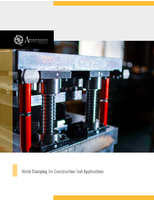Software automates electrical assembly design.
Press Release Summary:
SolidWorks® Routing software eliminates need to build new prototypes to refine cable, wire, and harness segments each time design is changed. Data import uses Microsoft Excel® spreadsheets from electrical CAD products to automatically add electrical details and adjust route diameter in designs, while harnessing tool automates design of routes and harnesses. Software bridges gap between electrical and mechanical design.
Original Press Release:
New Routing and Harnessing Enhancements from SolidWorks Power Automated Electrical Assembly Design
New SolidWorks Harnessing tool and additional SolidWorks Routing features speed design of wire connections between electrical subsystems
CONCORD, Mass., Feb. 23, 2004 - SolidWorks Corporation today reduced the high costs and extensive number of prototypes associated with designing wire-intensive electrical assemblies with new enhancements to its SolidWorks(r) Routing software, including a new harnessing tool. Now, engineers can accelerate production with one set of tools to automate the design of routes (the paths for wires, cables, tubes, and pipes) and harnesses (wire groups that connect electrical subsystems). These features bridge the gap between electrical and mechanical design to speed product development.
Chief among new electrical assembly design enhancements is SolidWorks Harnessing, which allows users to map out how each wire - complete with connectors and heat-shrink tubing - will fit into the group that is harnessed together along a path created in SolidWorks Routing. For example, an engineer would use SolidWorks Routing to model the path of electrical wires, cables, and harness segments in a car, and SolidWorks Harnessing to flatten the harness and provide specific details for each component and wire within the harness (as well as for cables and harness segments). This capability will help engineers build the car's electrical systems quickly.
Previously, engineers either used complex, high-priced 3D computer-aided design (CAD) systems or 2D products that forced them to spend hours building prototypes out of plywood, cardboard, or other materials. They then had to use string and/or a tape measure inside the prototype to determine cable/wire paths and lengths, re-build prototypes and re-measure with each significant design change. SolidWorks Routing and SolidWorks Harnessing eliminate excessive prototyping with automated routing and harness detailing (automatic sizing and dimension calculation) that help engineers get the design right the first time.
With these two products, mechanical engineers can work concurrently with electrical engineers on assembly and harnessing design and detailing, which was previously a sequential process.
"Cable and harness design is typically one of the last stages of development," said Greg Scott, design manager at the WABCO Transit Division of Wabtec Corp., which manufactures products for locomotives, freight cars, and passenger transit vehicles. "So if the overall assembly changes, the harness configuration will have to change, which often involves manual work. Being able to automate the initial harness design and subsequent changes while other engineers focus on routing and assembly design will save a lot of time and reduce the frustration of fixing errors after production begins."
Point-and-click design
Together, SolidWorks Routing and SolidWorks Harnessing deliver mouse-click route and harness design control so users can cut hours out of prototyping. Some key features include:
o Powerful auto routing provides quick and easy creation of electrical routes through a design to connect major components. In just a couple of minutes, engineers can use SolidWorks Routing to automatically create the paths for wires, cables, and harnesses between connections, including mounting clips and hangers, that hold these electrical routes in place.
o Wire harness flattening speeds product development by converting the 3D route geometry to 2D drawing views that show manufacturing engineers the exact specifications for each wire and component in the harness. SolidWorks Harnessing is the only mainstream 3D mechanical design product to deliver this feature.
o Harness/cable detailing enables engineers to automatically add harness details (including pins, coverings, looms, and eyelets) directly to the drawing so that cable/harness production teams have one source for the information they need. SolidWorks Harnessing is the only mainstream 3D mechanical design product to deliver this feature.
o Electrical data import uses Microsoft Excel(r) spreadsheets from electrical CAD (ECAD) products to automatically add electrical details and adjust route diameter in designs created in SolidWorks Harnessing and SolidWorks Routing. Engineers can import the electrical data before or after creating the route for design flexibility.
o Automated wire and component summaries in SolidWorks Harnessing calculate the amount of wire and the number of associated components a design requires.
"At every turn, SolidWorks software helps engineers reduce manual design work so they can finish better products faster," said Chris Garcia, vice president of research and development at SolidWorks Corporation. "SolidWorks Harnessing ensures engineers don't have to build new prototypes to refine cable, wire, and harness segments every time they change a design. Combined with SolidWorks 3D mechanical design software, SolidWorks Routing and SolidWorks Harnessing products give engineers the tools they need to complete electrical routes in product designs quickly and efficiently."
Pricing and Availability
These enhancements to SolidWorks Routing, including SolidWorks Harnessing, will be available in early Q2 2004. For pricing information, customers should contact their local reseller.
About SolidWorks Corporation
SolidWorks Corporation, a Dassault Systèmes S.A. (Nasdaq: DASTY, Euronext Paris: #13065, DSY.PA) company, develops and markets software for mechanical design, analysis, and product data management. Founded in 1993, SolidWorks' mission is to unleash the power of 3D for everyone in product development and foster a collaborative user community. In eight years of delivering product, SolidWorks has shipped more than 300,000 total seats of software worldwide. SolidWorks has offices around the globe and sells, distributes, and supports its products through a worldwide reseller network. For the latest news, information, or a live online demonstration, visit the company's Web site (www.solidworks.com) or call 1-800-693-9000 (outside of North America, call +1-978-371-5000).
SolidWorks is a registered trademark of SolidWorks Corporation. Other brand and product names are trademarks of their respective owners. Copyright (c) 2004 SolidWorks Corporation.




